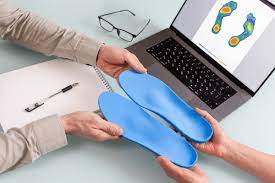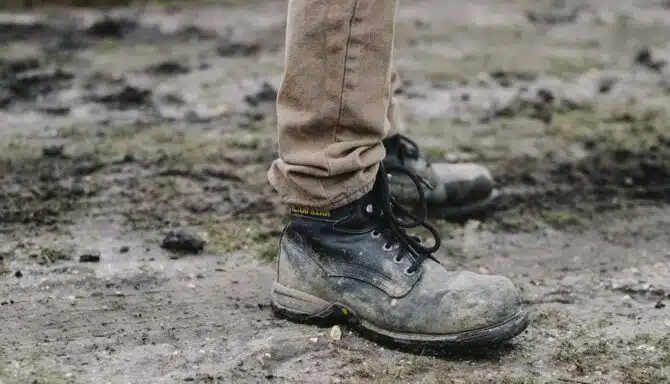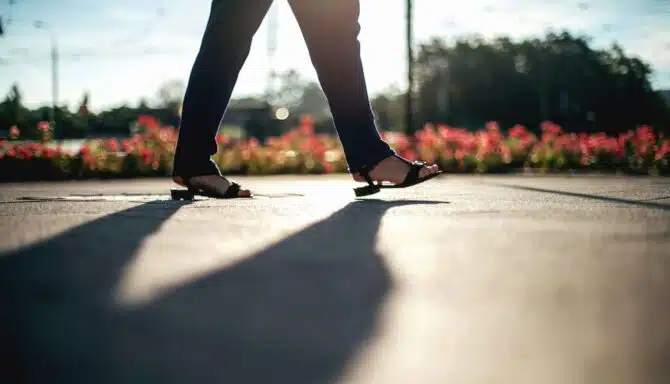October 17, 2024
Studies show that 8 weeks of a solid foot health workout can increase intrinsic foot muscle volumes by up to 22.8%. These are the various small muscle groups located entirely within the foot. They play a key role in stabilizing the arch, supporting balance, and enabling precise movements of the toes. Foot exercises can also help maintain extrinsic muscle strength. These are the muscles that connect to the foot, but are located just outside it, mainly in the lower leg, calf and Achilles tendon area. Foot exercises can also work your toes and the bottom of the foot, soothe pain, strengthen your ankles and prevent foot injuries. This article will list some of the best foot pain relief exercises you can incorporate into your daily routine, starting today!
Ball Stretch
View this post on Instagram A post shared by Feet First Clinic (@feetfirstclinic_)
Simply rolling your back and forth on a small ball can help with plantar fasciitis, arch pain, bottom of the foot pain, and general foot fatigue. You don’t need a therapeutic massage ball—a tennis, lacrosse or golf ball will work.
Sit or stand comfortably and place the ball under your foot.
Roll the ball slowly from your heel to your toes, applying gentle pressure for 2-3 minutes.
Switch to the other foot.
Toe Pulls
View this post on Instagram A post shared by Feet First Clinic (@feetfirstclinic_)
This exercise can help relieve plantar fasciitis, Achilles tendonitis, and general foot or calf tightness.
Sit with your legs extended in front of you and your back straight.
Use your hands to gently pull back on your toes, stretching the bottom of your feet and calves. Hold for 20-30 seconds.
Release and repeat 2-3 times, focusing on a slow, controlled stretch.
(Optional) Incorporate a resistance band by looping it around your feet and pulling back to deepen the stretch.
Toe Flex and Raise
View this post on Instagram A post shared by Feet First Clinic (@feetfirstclinic_)
Work out your tibialis anterior, improve toe flexibility and balance and strengthen your feet with this fun exercise.
Stand with your feet flat and toes planted firmly on the ground.
Lift your heels off the ground, keeping your toes pressed down, then slowly lower your heels back to the floor.
Repeat the movement 10-15 times, focusing on control.
Ankle Circles
View this post on Instagram A post shared by Feet First Clinic (@feetfirstclinic_)
This stretch helps strengthen your ankles and can improve general mobility.
Sit or stand with one foot lifted slightly off the ground.
Rotate your ankle slowly in large circles, first clockwise, then counterclockwise.
Repeat 10 times in each direction, then switch to the other ankle.
Calf Stretch on a Step
A great choice for calf strengthening and targeting the extrinsic muscle group, this is a simple stretch that just requires a set of stairs!
Stand on a step with your heels hanging off the edge and hold onto a railing or wall for balance.
Lower your heels slowly below the step, feeling a stretch in your calves.
Hold for 20-30 seconds, then raise your heels back up and repeat 2-3 times.
Marble Pick-Ups
View this post on Instagram A post shared by Feet First Clinic (@feetfirstclinic_)
This exercise can help with your general coordination and improve toe strength and flexibility, which may alleviate discomfort from conditions like bunions and arthritis. There are no time constraints with this one, simply focus on the task at hand.
Place small objects (like marbles) on the floor in front of you while seated.
Use your toes to pick up each object and drop them into a nearby bowl or container.
Repeat with both feet, aiming for 10-15 picks per foot.
September 26, 2024
Orthotics are supportive, custom devices designed to improve the alignment and function of the feet, ankles, and lower limbs. They aim to address specific issues like flat feet, overpronation, or arch support. This can help alleviate discomfort and prevent injuries by redistributing pressure and correcting abnormal movement patterns. Adequately fitted orthotics can significantly enhance comfort and mobility, making daily activities more manageable and pain-free.
Custom orthotics can make a big difference, but how exactly do orthotics correct foot alignment? And how do they work? Let's explain.
What are orthotics?
Orthotics are specialized, custom-designed insoles that you place inside your shoes. They come in many forms, and are molded and constructed specific to your unique foot needs. Their main job is to support and correct the alignment of your feet, which can help address various foot and lower limb issues. They essentially promote healthy biomechanics to ensure your body moves the way it's designed to.
Orthotics are custom-made specifically for your feet by a chiropodist (foot specialist). The chiropodist will do a biomechanical and gait analysis, and then take a mold of your foot (typically with a 3D digital scanner). The chiropodist then custom-designs the orthotics according to your specific needs, and a lab then constructs the orthotics according to the chiropodist's instructions.
It's important to note that while orthotics can be beneficial, they may not be suitable for everyone and can have some drawbacks, such as initial discomfort and the need for regular maintenance. Custom orthotics are more expensive than over-the-counter options, but they are an investment in your future — they may allow you to avoid more severe issues and chronic pain long-term, and can address foot concerns that over-the-counter insoles cannot. Not to mention, they are longer-lasting.
How orthotics correct foot alignment?
Orthotics are meant to modify how your foot moves and distributes pressure. They can help with several conditions, including:
Flat feet: Orthotics can support fallen arches to maintain and prop up the natural contours of your foot.
High arches: When you have high arches, excessive pressure is placed over a very small area of your foot. Orthotics help by cushioning and distributing pressure more evenly. If pressure is unevenly distributed across your feet, you're at a higher risk of overworking neighbouring parts of your foot.
Overpronation: If your feet roll inward too much when you walk or run (called "overpronation), orthotics can help correct this movement. They do this by creating a barrier to your foot's inward movement, which corrects the overpronation. (Interesting fact: people with flat feet are prone to overpronation, so the treatment for the two conditions is often the same).
Heel pain: Orthotics can reduce the strain on the plantar fascia and help alleviate heel pain.
By correcting foot alignment, orthotics can provide significant relief from pain and prevent future issues. The feet are our body's foundation, so when your feet are moving properly, it helps the rest of our body move properly. That allows muscles and joints to work the way they were designed to without being over-stressed. This then helps reduce pain - not only in our feet, but the rest of our body too!
Types of orthotics
There are many different types of orthotics designed for different footwear and activities. Click here to learn more!
Benefits beyond pain relief
Orthotics don't just help with pain—they can also play a proactive role in enhancing overall foot and body health. Proper alignment can lead to better posture, reduced knee and hip stress, and improved gait. Athletes often use orthotics to boost performance by optimizing foot mechanics, which then reduces the strain on the rest of their joints.
How to choose the right orthotics
If you're considering orthotics, here's what to keep in mind:
Consult a professional: A chiropodist can help determine if you need custom orthotics through a biomechanical assessment. They can then prescribe, design and fit your orthotics based on your activities and specific foot concerns. A chiropodist may also recommend footwear and over-the-insole options to test out first before going the custom route.
Consider your activities: Choose orthotics that match your lifestyle. For instance, if you're a runner, look for ones designed to absorb shock and provide stability. If you work in a setting with a formal dress code, you may want to opt for slimmer dress orthotics that will fit into your dress shoes.
Look at the full picture: Orthotics alone likely won't solve all your foot concerns. They're just part of the equation. You'll also want to ensure your wearing proper footwear and maintaining an active, healthy lifestyle. If you have chronic pain or a conditions like arthritis, regular exercise and stretching is very important to build strength in your feet and ankles. Orthotics are essentially meant to supplement a healthy lifestyle - not substitute it.
How to get the most out of your orthotics
Once you have your orthotics, wear them regularly to see the best results. They take some time to get used to, so gradually increase the time you wear them daily. Also, remember that orthotics are just one part of foot health—maintaining a proper exercise routine and suitable footwear are equally important. To ensure the longevity of your orthotics, clean them regularly and follow any specific care instructions provided by the manufacturer or your chiropodist.
September 19, 2024
Whether you're an experienced marathoner or an occasional runner, healthy, happy feet are core to your running success. After all, our feet are the unsung heroes that carry us through kilometres of training and races. Without proper care, our feet and body can only take us so far before we develop aches and injuries.
Proactively caring for your feet can help prevent injuries and boost your performance. In this blog post, we dive into our top foot care tips for runners to keep your feet in tip-top shape.
Choose the right shoes
It all starts with the right pair of running shoes. Everyone's feet are different, so there's no one-size-fits-all. Make sure your shoes fit well—there should be about a finger's width of space between your longest toe and the end of the shoe. The best way to find your ideal shoe is to visit a specialty running store (like our Toronto foot clinic!) where they can analyze your gait and recommend a shoe that suits your running style and foot type.
Replace your shoes regularly
Another one of our top foot care tips for runners is to replace your running shoes when they wear out. Running shoes don't last forever. Generally, they should be replaced every 450-800km. Worn-out shoes lose their shock absorption, grip, and support, which can lead to injuries. Look for signs like flattened soles or uneven tread to know when it's time for a new pair. You may also notice wrinkles among the various areas of cushioning.
Incorporate foot-strengthening exercises
Strong feet are less prone to injury. Simple exercises like toe curls, heel raises, and foot stretches can help build strength and flexibility. Try using a resistance band to stretch your feet and calves, and don't forget to roll a tennis ball under your foot to relieve tension and keep things limber. You may also find a lacrosse ball effective for a more rigid plantar fascia massage.
Pay attention to your running form
Sometimes, foot pain can be traced back to improper running form. Ensure you're landing with your feet underneath your hips rather than over-striding, which can put unnecessary stress on your feet. If you're unsure about your form, consider working with a coach or getting a gait analysis to pinpoint any issues.
Stretch and foam roll
Stretching isn't just for your legs and back; your feet need love, too. Incorporate foot stretches into your routine, focusing on the Achilles tendon, calves, and the bottom of your feet. For example, do a calf stretch by standing on a step and letting your heels drop below the level of the step. Foam rolling can also help, particularly if you're experiencing tightness in your plantar fascia or Achilles tendon.
Keep your shoes dry
Blisters and fungal infections love a moist environment. Make sure your feet are dry before putting on socks and running shoes. Choose moisture-wicking socks designed to remove moisture from your skin to help keep things dry. This can prevent blisters and reduce the risk of fungal infections. Consider using foot powder or antiperspirant if you're prone to sweaty feet.
For additional moisture prevention, buy two of the same pairs of running shoes and cycle them in and out. Longer durations between uses allow the cushioning to decompress and give your shoes more time to dry thoroughly.
Listen to your body
Our final foot care tip for runners is to always listen to your body. If you're experiencing persistent foot pain, don't push through it. Ignoring pain can lead to more serious injuries later. Rest, assess, and seek professional advice if needed. Remember, rest days are just as important as training days. They give your feet and body the time they need to recover and adapt to the stress of running.
August 26, 2024
As children’s foot development takes its first steps, it’s common to encounter a few bumps along the way. From in-toeing to Sever’s disease, these growing pains are part of the journey as little ones explore the world with developing feet. Let’s take a look at what foot conditions might correspond with your child’s age.
Ages 1-3: In-Toeing and Toe-Walking
Troublesome toes occurring during the “terrible twos” can be concerning. But these quirky walking patterns are totally normal developmental milestones for children's foot development. No cause for alarm or invasive treatment!
In-toeing, also known as pigeon-toeing, is when a child's feet turn inward instead of pointing straight ahead while walking. Toe walking is when a child walks on the balls of their feet with their heels off the ground.
Up to Ages 3-4: Flat Feet
Children around this age will have pen planus, also known as fallen arches or flat feet. This is when the entire sole of their foot contacts the ground while standing and walking. Traditional children's foot development is at play here, as arches in children's feet develop around age 6. No treatment is generally needed for flat feet before this point, unless your child’s flat feet persist as they age, in which case you may want to consider custom orthotics, stability shoes and other treatments for flat feet.
5+ Years Old: Blisters
As kids get older, gain a sense of independence and participate in more physical extracurricular activities and outdoor play, they may start to develop skin conditions on their feet. Enter: blisters. These are a pretty common condition that’s usually harmless, but can painful and bothersome for kids when they walk. Blisters form as a result of excessive friction between shoes and the foot’s skin.
Read here to learn the best ways of preventing foot problems like blisters and how to choose the right shoes for children!
Puberty and Growth Spurts: Sever’s Disease
Did you know that the concept "growing pains" in children is not what most people think it is? While kids may experience pain as they grow, the pain itself is not caused by growing.
But what can cause pain for kids going through puberty is something called Sever’s Disease, which is like a kid’s-only version of injuries like plantar fasciitis, Achille’s tendonitis and heel spurs.
Sever's disease kicks in when a growing heel gets overworked, causing inflammation. It leads to sharp heel pain, especially when kids are on the move, like during sports and playtime! Kids between 9 and 14 are the most vulnerable.
Solid foot care for kids can help offset Sever’s disease. Try the RICE method: rest, ice, compression and elevation. You should also buy your child supportive footwear to ease the strain on the heel. Avoiding high-impact activities can also help speed up recovery.
June 27, 2024
Construction workers face challenging demands on the job site, including long hours, potential safety hazards, and variable weather conditions. There are few jobs where footwear is more important than on a construction site. Proper footwear is critical for comfort, safety, and overall health.
This blog explores how to find the best shoes for construction workers. We dive into the balance between durability, safety features, and foot health, which are vital for your job.
Durability
Construction sites are full of heavy equipment and sharp objects and tools. Hazards range from sharp objects to heavy machinery. The best shoes and boots for construction workers should be durable, made from leather or synthetic blends, and be able to withstand abrasions and falling objects. Keep your toes and feet safe with toe caps or sturdy outsoles - ideally both.
Refined safety features
Safety is a top priority on the job site. When choosing footwear, opt for models that meet or exceed industry safety standards set forth by the Canadian Centre for Occupational Safety and Health.
Features like steel or composite toe caps provide essential protection against impact and compression injuries, while puncture-resistant midsoles shield your feet from sharp objects on the ground.
Additionally, slip-resistant outsoles help prevent accidents on wet or slippery surfaces, reducing the risk of slips and falls. Refer to the CCOSH's guide for symbols, or markings, on footwear to determine which is appropriate for the job.
Comfort
Long hours spent on your feet can be grueling. It's not uncommon for construction workers to be on their feet for 10+ hours per day. Shop for shoes with adequate support through the arch and heel, and invest in removable insoles or orthotic inserts for even greater support. If you're a construction worker in Toronto, our licensed chiropodists can do a biomechanical assessment to determine the best insoles for your foot condition.
Grip and footing
The type of flooring used in the workplace influences comfort, especially on feet. Unforgiving surfaces like concrete are the least comfortable to work on—your feet and legs absorb all the impact compared to a softer surface. Further, slippery floors (whether smooth or wet) are hazardous for slips and falls. If not careful, you can be exposed to injuries like sprained ankles or broken foot bones.
Fit
Durability and safety features are effective only when your shoes fit the contours and mould of your foot. When trying construction footwear, test out the fit with the same socks and attire you'd be wearing on the job site. If you decide to purchase online, we recommend using the manufacturer's sizing guide for directions, or finding a local retailer to try the shoes on in-store.
May 20, 2024
As the temperatures rise and the sun shines brighter, it's time to ditch the closed-toe shoes and slide into something more comfortable and breathable. Yes, it's sandal season! But with so many options available, how do you choose the best sandals for your summer adventures? We've got you covered.
In this guide, we'll explore the essential features to look for in summer sandals and introduce you to some top picks that seamlessly blend style with comfort.
Cork footbed
One key feature to consider when selecting summer sandals is the footbed material. Cork footbeds are famous for their ability to mould to the shape of your foot over time, providing personalized support and cushioning.
Additionally, cork is lightweight and absorbs shock, making it an excellent option for all-day wear. Whether strolling along the boardwalk or exploring a new city, sandals with cork footbeds ensure your feet stay comfortable and supported.
Arch support
Arch support is essential, especially if you plan on wearing your sandals for extended periods. It distributes weight across your feet, reducing strain and preventing discomfort. A lack of arch and forefoot support can lead to foot problems like plantar fasciitis or metatarsalgia.
Look for sandals with arch support or removable insoles. You can customize the level of support to your liking. Your feet will thank you after a long day of sightseeing or outdoor activities.
Backstraps for support
While slip-on sandals are convenient, they may provide a different level of support and stability than those with backstraps.
Backstraps help secure the sandals to your feet, preventing them from slipping and sliding with each step. Added stability is particularly beneficial if you plan to engage in more active pursuits or tend to pronate or supinate. Backstraps come in various styles, from adjustable buckles to elasticized bands, allowing you to find the perfect fit for your feet.
Our top picks
Now that we've covered the essential features to look for in summer sandals let's introduce you to some top picks that effortlessly combine style with comfort.
NAOT Cornet and NAOT Castelo
Best for cork footbeds
With their contoured cork footbeds and adjustable backstraps, NAOT sandals offer exceptional comfort and support. The NAOT Cornet and NAOT Castelo styles feature chic designs that transition seamlessly from day to night.
Mephisto Hester and Mephisto Hetty
Best for cork footbeds
Mephisto sandals are renowned for their superior craftsmanship and comfort technology. The Mephisto Hester and Mephisto Hetty models boast cushioned footbeds with arch support and durable backstraps for added stability.
Aetrex Jess
Best for arch support
The Aetrex Jess sandals feature a built-in Lynco orthotic footbed for maximum support and alignment. The adjustable backstrap ensures a secure fit, making them ideal for all-day wear.
NAOT Enid and NAOT Amadora
Best for backstrap support
NAOT offers a range of stylish sandals with cork footbeds and backstrap designs. The NAOT Enid and NAOT Amadora are built with quality and comfort in mind. The three variations three are perfect for summer adventures.
Mephisto Norine
Best for backstrap support
The Mephisto Norrine sandals combine elegance with functionality. Featuring Soft-Air technology and adjustable straps, they provide unparalleled comfort and support for any occasion.






